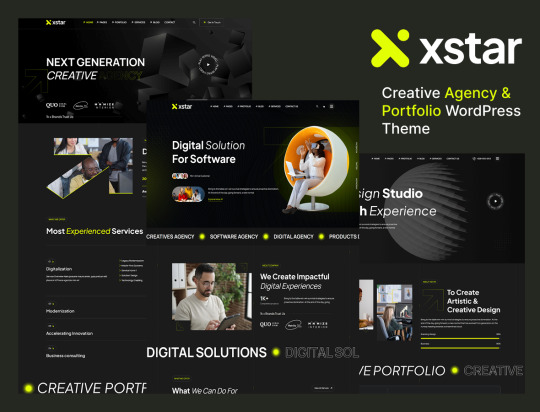#PortfolioWebsite
Explore tagged Tumblr posts
Text
"Passionate graphic designer from New York, delivering creative solutions and technical support to help clients thrive!"
Hi, I’m Evans Dezven, a skilled UI/UX designer based in New York, USA, dedicated to creating intuitive and visually compelling digital experiences. As a freelancer, I’m available to collaborate on design projects that demand a perfect blend of creativity, technical expertise, and user-centered design.
I hold a degree from Chicago University with a background in computer science and design, enabling me to craft innovative solutions like the acclaimed “Genius In You” portfolio website. My expertise lies in delivering modern, functional, and aesthetically pleasing designs tailored to meet client needs while enhancing user engagement.
With a strong grasp of design trends, user behavior, and cutting-edge tools, I aim to help clients stand out in today’s competitive digital landscape. Whether you need a sleek portfolio, a polished mobile app design, or a revamped digital platform, I’m here to deliver exceptional results.
Explore my portfolio and services at https://iakash.digital/ or visit my personal site,https://iakash.digital. You can reach me via email at [email protected] or call (+91) 987-011-3409. Let’s collaborate to turn your vision into reality and create outstanding digital experiences that captivate and inspire!
#UIUXDesigner#FreelanceDesigner#DigitalDesign#CreativeSolutions#UserExperience#UserInterface#WebDesign#AppDesign#PortfolioWebsite#ModernDesign#InnovativeDesign#GraphicDesign#NewYorkDesigner#DesignTrends#DigitalExperience#ClientEngagement#CuttingEdgeDesign#DesignExpert#AvailableForProjects#DesignInspiration
2 notes
·
View notes
Text

✨ Excited to share my latest web design project!
This project showcases my creativity and dedication to building modern, user-friendly websites tailored to each client’s needs. I specialize in:
🚀 Custom Website Development 🌐 WordPress Website Development 🎯 Fast, responsive, SEO-optimized websites
Whether you're launching a startup, growing your brand, or just need a fresh online presence — I’m here to help!
📩 Let’s build something great together! Reach out if you’re interested in a project or need any web development support.
📬 Contact Info: Email: [email protected] WhatsApp: 01570223157 Website: www.gpad.com.bd
#web development#website#website development#website management#wordpress development#portfoliowebsite#portfolio#travel#wanderlust#travel blog
0 notes
Text
🌟 tonymacchia.com is AVAILABLE!
The perfect domain for your personal brand, portfolio, or professional website. Clean, professional, and instantly recognizable as yours!
🔗 Secure it now: www.godaddy.com/domainsearch/find?domainToCheck=tonydimacchia.com
0 notes
Text
Responsive Portfolio Website
A responsive portfolio website I made for the financial services consultancy Kunnig Konsulting: kunnigkonsulting.com

The same page on different devices: on a laptop, on an iPad, and on an iPhone

0 notes
Text
10 Best Resume WordPress Themes

For your online portfolio, are you having trouble selecting the ideal Resume WordPress theme? With so many options, it’s normal to feel confused about which style best suits your needs. You may select a theme that looks good but performs poorly on various devices.
Imagine spending hours personalizing your website only to find that your theme is unresponsive and doesn’t effectively showcase your achievements. It’s frustrating, especially when showcasing your professionalism is your top priority.
This blog will guide you through the Top 10 Resume WordPress Themes, highlighting their features, advantages, and versatility. You’ll gain the skills necessary to choose a theme that enhances your portfolio and ensures it loads quickly, looks outstanding, and functions smoothly.
Read Full Bolg Table Of Contents 👇
Key Features of Best Resume WordPress Theme
10 Best Resume WordPress Theme
Diego – Creative Personal Portfolio & Resume WordPress Theme + RTL
Hobi – Personal Portfolio WordPress Theme
Exdos – Digital Agency WordPress Theme
Termico – Spa and Beauty Salon WordPress Theme
Findup – Directory & Listing WordPress Theme
Beakai – Multipurpose Business WordPress Theme
Vome – Multipurpose Film Studio Movie Production WordPress Theme
Wetland – MultiPurpose WordPress Theme
Harry – Creative Agency & Portfolio WordPress Theme
Fundu – Religious WordPress Theme + RTL
Common Mistakes to Avoid When Choosing a WordPress Theme
Final Insights
#ResumeWordPressThemes#WordPressThemes#JobSearch#ResumeTemplates#WebDesign#PortfolioWebsite#FreelancerLife#OnlineResume#CareerDevelopment#CreativeResume#CustomThemes#PortfolioTemplates#ResumeDesign#WordPressWebsites#CareerGrowth#ProfessionalPortfolio#WebsiteInspo#ThemesForResumes#BlogDesign#WebDev
0 notes
Text
Professionals & Consultants, this one’s for you! Dpearn.com is a short and professional domain ideal for personal branding or a portfolio. Snag it today: https://www.godaddy.com/domainsearch/find?domainToCheck=dpearn.com
1 note
·
View note
Text

Build a Stunning Website That Grows Your Business!
Professional & Custom UI/UX Designs
SEO-Friendly & Fast-Loading Websites
E-commerce, Portfolio, & Business Websites
Secure with SSL & Mobile-Friendly
Your Website = Your Business Growth!
Let’s create a high-performing, visually stunning website that attracts customers & boosts conversions.
📩 Get a Free Consultation Today!
#WebsiteDevelopment#WebDesign#WebDevelopment#CustomWebsite#WebsiteForBusiness#GrowYourBusiness#DigitalTransformation#BrandSuccess#BusinessGrowth#OnlinePresence#EcommerceWebsite#ShopifyDevelopment#WordPressWebsite#PortfolioWebsite#LandingPageDesign#KTIG#KovaiTechIndiaGroup
0 notes
Text

🌟 Stand Out with Xstar - Creative Agency & Portfolio WordPress Theme! 🎨
🤔 Want a unique, SEO-friendly portfolio website? Xstar is the perfect WordPress theme for creative agencies, designers, photographers, developers, and artists. Build a stunning, modern portfolio that captivates clients and ranks high on search engines.
Why Xstar?
✅ Unique, Elegant Design: Showcase your work with a contemporary, eye-catching layout. ✅ Fully Customizable: Craft your perfect site with WPBakery and Elementor compatibility. ✅ SEO Optimized: Boost your visibility and attract more clients with top search rankings. ✅ Mobile-Friendly: Look flawless on all devices, from smartphones to desktops. ✅ Easy to Use: Create and update your portfolio effortlessly, no coding required.
🚀 Ready to Elevate Your Brand? Transform your online presence and attract your dream clients with Xstar. Don’t wait – create a portfolio that truly shines!
👉 Explore the Demo & Download Now!
#Xstar#CreativeAgency#PortfolioWebsite#WordPressTheme#ModernDesign#SEO#ResponsiveDesign#WebDevelopment#UniqueStyle#CreativeShowcase#techbe#nextjs#customizable#webdesign#technology#woocommerce#CreativePortfolio#SEOOptimized#WebDesign
1 note
·
View note
Text
I will do Shopify theme customization professionally.
Shopify provides merchants with a user-friendly platform that offers customization, scalability, and powerful tools for managing an online business. Key benefits include ease of use, mobile responsiveness, integrated payment gateways, built-in marketing and SEO tools, reliable hosting, and 24/7 support. Shopify also offers a vast app store for enhanced functionality, allowing merchants to streamline operations, attract more customers, and scale their businesses efficiently. Whether starting out or growing, Shopify is a reliable solution for eCommerce success.
My personal portfolio website: https://www.tanzidislam27.digitalproducts-review.com/
visit now: https://www.fiverr.com/s/yvw1PNA

#shopifystore#shopifywebsite#shopifydesigner#personalwebsite#PortfolioWebsite#highlights#everyonehighlights#shopifyexpert#everyone#shopifydropshipping#websitedevelopment#website
1 note
·
View note
Text

How To Create a Personal Portfolio Website in WordPress?
#PersonalPortfolio#PortfolioWebsite#WordPress#HowToCreate#WebDevelopment#WebsiteDesign#WordPressTutorial#OnlinePortfolio#FreelancerWebsite#CreativePortfolio#BuildYourWebsite#WordPressTips#DesignYourFuture#WebDesignTips#SelfPromotion#DigitalPresence#ShowcaseYourWork#Coding#Blogging#FreelanceLife
0 notes
Text
















Create a stunning website to showcase your art with lalilala.org! Use promo code TUMBLERARTIST to get a special discount of $180 CAD on your new website. Check out the amazing websites we've designed and join our community of talented artists.
#ArtistsOnTumblr#ArtPromotion#WebsiteDesign#ArtistWebsites#PortfolioWebsite#CreativeWebDesign#AffordableWebDesign#ArtCommunity#SupportArtists#PromoCode#DiscountOffer#ArtisticPortfolio#DigitalPortfolio#TumblrArtist#TumblrPromo#WebDesignDeal#CreativePortfolio#ArtOnline#PromoCode180#TumblrArtDeal
0 notes
Text

Hi, I’m Akash Agarwal, a passionate and skilled UI/UX designer from Gurgaon, India. With a strong background in computer science and design, I am dedicated to creating intuitive, user-friendly, and visually captivating digital experiences. As a freelancer, I am available for exciting UI/UX design projects, bringing creativity and technical expertise to every collaboration.
I hold a degree from Chicago University, where I honed my skills in crafting innovative solutions tailored to client needs. One of my standout achievements includes designing “Genius In You,” a highly regarded portfolio website that exemplifies creativity and functionality. My expertise lies in delivering sleek, modern, and responsive designs that enhance user engagement and deliver meaningful results.
Whether it’s building a stunning portfolio website, designing a polished mobile app, or revamping an existing digital platform, I aim to bring unique value to every project. My approach combines an understanding of user behavior, design trends, and cutting-edge tools to help clients stand out in the competitive digital space.
Explore my portfolio and discover how I can transform your vision into reality by visiting https://iakash.digital/. You can also reach me at [email protected] or call (+91) 987-011-3409 to discuss your project needs. Let’s collaborate to create exceptional digital experiences that captivate users and elevate your brand!
I’m excited to bring my skills and passion to your next project and help you achieve outstanding results in the digital realm.
#UIUXDesigner#FreelanceDesigner#DigitalExperience#UserFriendlyDesign#CreativeDesign#ModernUI#UXExpert#WebDesign#MobileAppDesign#ResponsiveDesign#PortfolioWebsite#DesignTrends#UserEngagement#InnovativeSolutions#DesignForSuccess#BrandElevation#UIUXFreelancer#GurgaonDesign#TechMeetsCreativity#DigitalTransformation#LetsCollaborate
0 notes
Text
✨ Excited to share my latest web design project!
This project showcases my creativity and dedication to building modern, user-friendly websites tailored to each client’s needs. I specialize in:
🚀 Custom Website Development 🌐 WordPress Website Development 🎯 Fast, responsive, SEO-optimized websites
Whether you're launching a startup, growing your brand, or just need a fresh online presence — I’m here to help!
📩 Let’s build something great together! Reach out if you’re interested in a project or need any web development support.
📬 Contact Info: Email: [email protected] WhatsApp: 01570223157 Website: www.gpad.com.bd
#web development#website#website development#wordpress development#website management#portfoliowebsite#portfolio
0 notes
Text
DG Emperor: Crafting Exceptional Portfolio Websites in Navi Mumbai
DG Emperor specializes in crafting stunning portfolio websites in Navi Mumbai. Elevate your online presence with bespoke designs that showcase your unique talents and services. From concept to launch, trust DG Emperor for professional, user-friendly websites tailored to your needs. Contact us today to start your digital journey

0 notes
Text

Web developer Ingo Steinke, Berlin
#web development#portfoliowebsite#responsivewebsite#responsivedesign#sustainablewebdevelopment#wordpress#web developer#referenzen
0 notes
Text
11 Best Personal Portfolio WordPress Themes

Personal Portfolio WordPress Themes are designed to help you showcase your skills and work beautifully. They are perfect for creatives like designers, photographers, writers, and freelancers who want to present their portfolios online. These themes come with easy-to-use features and customizable options to make your website look just the way you want.
With responsive designs, your portfolio will look great on any device, whether a computer, tablet, or smartphone. Personal Portfolio WordPress Themes are also SEO-friendly, meaning they help your website appear higher in search engine results, making it easier for people to find you. They provide an excellent platform to impress potential clients and employers, showing off your talents in the best possible way.
Key Features of Best Personal Portfolio WordPress Themes One of the key advantages of using a Personal Portfolio WordPress theme is its ease of use and flexibility. Most personal portfolio themes come with various pre-made demos that can be imported with a single click, allowing you to get your website up and running quickly. These demos are designed to give you a head start by providing a well-structured layout that you can customize to fit your specific needs.
Customization is a breeze with these themes, as they often come with powerful tools that allow you to personalize every aspect of your site. You can easily change colors, fonts, and layouts to match your style. Many themes are compatible with popular page builders like Elementor or WPBakery, which offer drag-and-drop functionality, making it simple to create unique page designs without any coding knowledge.
Responsive design is another essential feature of these themes, ensuring that your website looks great on all devices, from desktops to smartphones. This is crucial in today’s digital landscape, where users access websites from various devices with different screen sizes.
Additionally, personal portfolio WordPress themes are typically optimized for SEO, helping your site rank higher in search engine results and improving its visibility to potential clients and employers. Some themes also include e-commerce compatibility, often through integration with WooCommerce, allowing you to sell products or services directly from your website.
Read More
#BestPersonalPortfolio#WordPressThemes#PortfolioDesign#WebDesign#PersonalPortfolio#CreativeThemes#WordPressWebsites#ThemeInspiration#ResponsiveDesign#FreelancePortfolio#OnlinePortfolio#WebDeveloper#DigitalDesign#WordpressTemplates#PortfolioWebsite#ShowcaseYourWork#ModernThemes#UserExperience#DesignTrends
0 notes